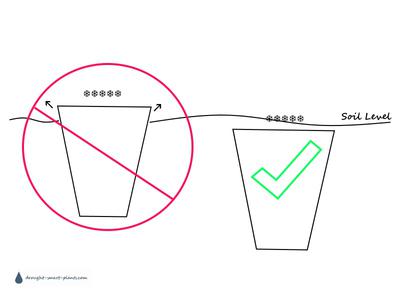
by Jacki
(Grand Forks, B.C.)

Diagram showing where the best soil level should be
“I am very new to gardening, and I have been trying to use plants that don’t need much water. I love elfin thyme. Just wondering what the proper way to plant the plugs is. I am fairly certain I did it wrong the first time and now the leaves look all dried out and I fear they are not long for this world.”
Here’s Megans question about planting thyme plugs, and was concerned that she did it wrong.
I’ve planted a lot of these little guys, and one thing that never surprises me is that they look fine for a couple of days then look completely dead, even though you watered them in, and continue to water on a daily basis, depending on the weather.
My advice? Don’t give up on them! They might surprise you by coming back to life – it might not be right away, in fact I’ve had some areas that I thought were dead, but the following year, there they were. It takes a long time for them to get established.
I try to plant them when we have some showery days in the weather forecast, any time from May to July. After that, it’s too hot, and you will have even less success.
One of the main things is that the soil level should be above the top of the cell that they’re grown in. This ensures that the soil in the cell (which is most likely some kind of peat based potting soil) doesn’t wick the moisture away into the air.
Cover the cell past the bottom of the plant – don’t worry they’re not like other plants where the recommendation is to plant them at the same level as they were grown. Stems of thyme, especially the creeping kinds like Elfin, will produce more little rootlets. This helps anchor them to their surroundings.
Mulch with some kind of gravel – I’ve used pea gravel, or even turkey grit which is a lot smaller. Just pour it carefully on top of each plug, and then brush some of it away from the crown. This helps with moisture control, keeping a tiny bit of water right by the roots so it’s easily available to the plant.
Weed, carefully. Don’t let the weeds get too big before doing this – it’s easy to pull out the barely rooted in plugs too.

